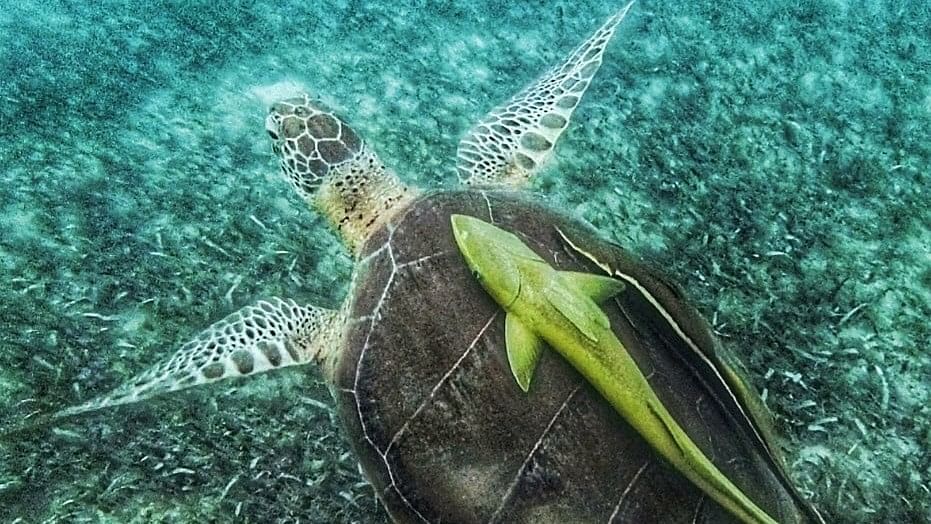
A green sea turtle and a suckerfish attached in a commensal relationship.
Photo: Eva Badola
Visiting the low saturated rainforest around Tulum, I succumbed to an eerie feeling. As we ventured deeper, the wind howled stronger through the woods, as if echoing some chants. Suddenly, a portentous shadow lingered and faded away in the woods. My Mexican guide, Juan, instructed me to tread cautiously as jaguars roamed the area. We were in the native forest of Indigenous Maya people, who belonged to the Mesoamerican civilisation that emerged in 1500 BC.
The Mayans built Tulum, a walled city that served as a trading port, along the Caribbean coast of Mexico’s Yucatan Peninsula. Though Tulum flourished from the 13th to 15th century, when the Spanish invaded it in the 16th century, Mayans fled and took refuge in the nearby forest for 300 years.
The rainforests became sacred places for Mayans, where they believed gods and spirits inhabited. “Living close to nature, Mayans considered that animals possess spiritual souls. So, they always worshipped and protected the wilderness,” said Juan. “And in return, no animal has ever harmed us,” he added to ease my fears about jaguars.
Although the dense jungles, pristine coastlines, and freshwater pools (cenotes) have blessed Tulum with outstanding beauty and wildlife, mindless developments driven by over-tourism are destroying it, threatening countless species like jaguars, turtles, and dolphins.
Luckily, there are still a few places protecting wildlife, where tourists can responsibly enjoy close encounters with wild animals.
At the Sian Ka’an reserve & Akumal
“Look at that living dinosaur,” exclaimed Frank Vidal, our guide, pointing towards a massive American crocodile concealed in the marshes of Sian Ka’an. Only three hours from Tulum, Sian Ka’an is a 5,280-square-kilometre biosphere reserve and UNESCO World Heritage site.
Crocodiles, sharing a common heritage with dinosaurs, held a religious connection with the ancient Mayans. Worldwide, over half of crocodile species are threatened with extinction. However, Vidal mentioned, “They are thriving in the reserve because the Mayans still value and protect them.”
Vidal organises community-based tours where he takes a maximum of six passengers per boat at one time, as opposed to throngs of tourists, to reduce eco-stress. Such tours pre-educate visitors to leave minimum footprints by not littering and respecting animals.
Additionally, tourists spend money at locally owned restaurants and handicraft products to support the local economy. As our boat cruised into the vast ocean, a pod of curious Bottlenose dolphins swam towards us. Playfully, they clicked, chirped, and whistled — creating all sorts of notorious noises.
While it was tempting to interact with them, swimming with dolphins is prohibited, as it can transfer diseases or disrupt their behaviour. However, tourists were contented seeing the dolphins roam freely in the wild waters rather than being captive in some aquarium.
“Capture this enchanting phenomenon!” exclaimed Isaac, my snorkelling instructor. As I readied my underwater camera, a massive 100 kg green sea turtle widened its flippers and swam upwards to gasp some air. We were snorkelling in Akumal Bay, just a 25-minute drive from Tulum. The bay is part of the world’s second-largest reef called the Mesoamerican Barrier Reef. The 1540-kilometres reef houses 500 fish species and several corals and shark varieties.
However, Akumal, meaning ‘place of turtles,’ is renowned for harbouring critically endangered hawksbill and endangered green and loggerhead turtles. “Turtles, revered as Mayan’s ancestral animal, have uniquely adapted to both land and sea,” shared 18-year-old Isaac. However, these turtles are under persistent stress as many tourists try to touch, chase, or harass them. “That’s why snorkellers should respect a 15-foot distance from turtles,” Isaac emphasised. Similarly, water flippers are not allowed as they can injure the turtles and damage corals.
Cenote Azul
Ruffling through a small jungle, I found Cenote Azul, just 45 minutes from Tulum. Cenotes are freshwater pools that are highly sacred to Mayans. Suddenly, a chirping sound echoed within the shrubs. I spotted coatis, peculiar furry-reddish animals that appeared like a bizarre mix of a raccoon, anteater, and hog. Playing hide and seek, the band of coatis hesitantly moved closer to me in the hope of food. However, disappointed for not receiving any treats, the group blended back into the woods.
Coatis have an agile appetite and will hustle around tourists for snacks. However, feeding overly salty and sweet human foods does more harm than good. It not only disrupts their instincts of foraging for fruits and tubers but also muddles nature’s balanced food chain. Green iguanas can also be seen winging on trees in Azul. When approached, they inflate their necks and raise their spikes while enormous black iguanas, with their spiny tails, cunningly blend into the rocks around the pool. Despite these quirky survival traits, black spiny-tailed iguanas are listed as threatened in Mexico.
However, the Mayans revered iguanas as symbols of wisdom and transformation and consumed them only for medicinal purposes. But with the growing tourist demand for iguanas as prized delicacies, they are illegally hunted down to supply trendy restaurants with their meat. However, a live iguana is far more majestic than a dead one. Also, as primary herbivores, iguanas are natural seed dispersers and help maintain plant populations.
Thanks to cenotes like Azul, iguanas are not only protected but also attract eco-tourists, helping the tribe earn income. Bobbing their heads, these lizards appeared as bearers of Mayan spirits, spreading conservation messages to the tourists.